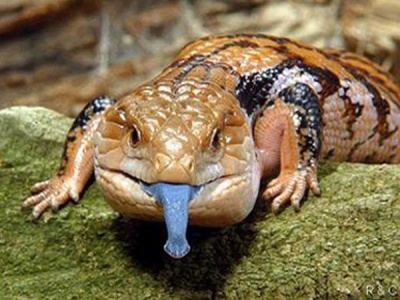Blue-tongued Skink Care
Category: Lizard

Facts about Blue-tongued skink care. "Scientific name for Blue-tongued skink is Tiliqua". Blue-tongued skinks are among the largest members of the skink family. They comprise of the Australasian genus known as tiliqua. The Blue-tongued skink have a large blue tongue that they use to scare off the enemies. Mostly they are kept as house pets because it is easy to keep them and they have a very attractive look.
The Blue-tongued skink are found in Australia with an exception of tiliqual gigas which is normally seen in New Guinea. This does not mean that they are only limited to Australia and New Guinea because they are also exported to other parts of the world where they are bred. The most common countries are US, Europe and Japan.
The size of the blue-tongued skinks differs according to the species and sex. But most of them are between 14 and 18 inches(35.5 to 45 cm) long in adulthood. When kept in captive they can live up to 20 years old and above.
The blue-tongued skinks are omnivores and would consume almost everything given to them. They are fed with various diets which include; Crickets, wax, worms and cockroaches. One can give the dark leafy greens too. Fruits such as bananas, apricots, apples and figs are ideal. Canned lizards diets can also be given for special treats.
Even though the Blue-tongued skink can be fed with almost everything it is essential to rub their diets with calcium and vitamin supplements. For the young ones the food should be added supplements regularly so that they can grow strong.
Ensure that the Blue-tongued skink have plenty of water. Keep a good sizable bowl of water where it is accessible because they love to drink regularly.
Most blue-tongued skinks adapt to different environments and settings so when housing them take that into considerations. Do several experiments with different substrates so that you can know what suits them. Above all, make sure that the substrate you choose will be easy to keep clean.
Since the Blue-tongued skink are curious animals you can add some furnishings in their cage to keep them busy. Logs kept on top will be good too because they will provide hiding and climbing places for them. For the vegetation choose the ones that are not toxic because as we said earlier they eat almost anything.
Lighting is also very important for the blue tongued skink. During the day you can keep their house with around 80 degrees Fahrenheit (27 c) dropping them slightly to 70 degrees Fahrenheit (21 c) at night. If possible make sure that at one side of their cage there is a basking area.
Choose standard basking bulbs to provide light for them during the day for your Blue-tongued skink. During the night heating pads are good because they can keep the temperature within the right range. Mercury vapor bulbs are good too though they require large enclosure. They are mostly used because they can provide both light and heat.
Blue-tongued skink are friendly and unlike other species that don’t like being handled, handling these is very easy. Start by handling them on a daily basis so that you can build their trust. They are very intelligent animals thus making good pets.

 Back To Category Lizard
Back To Category Lizard